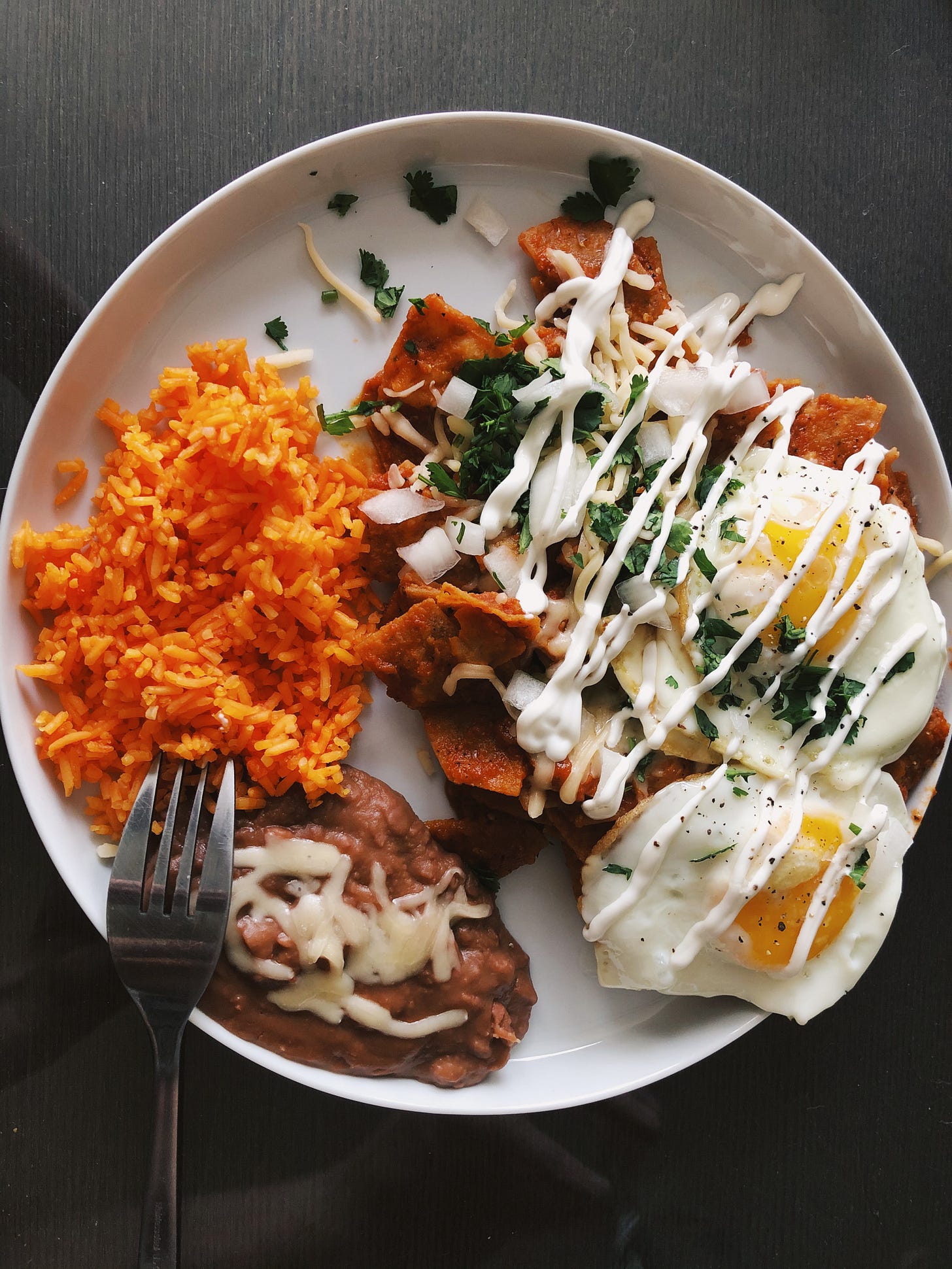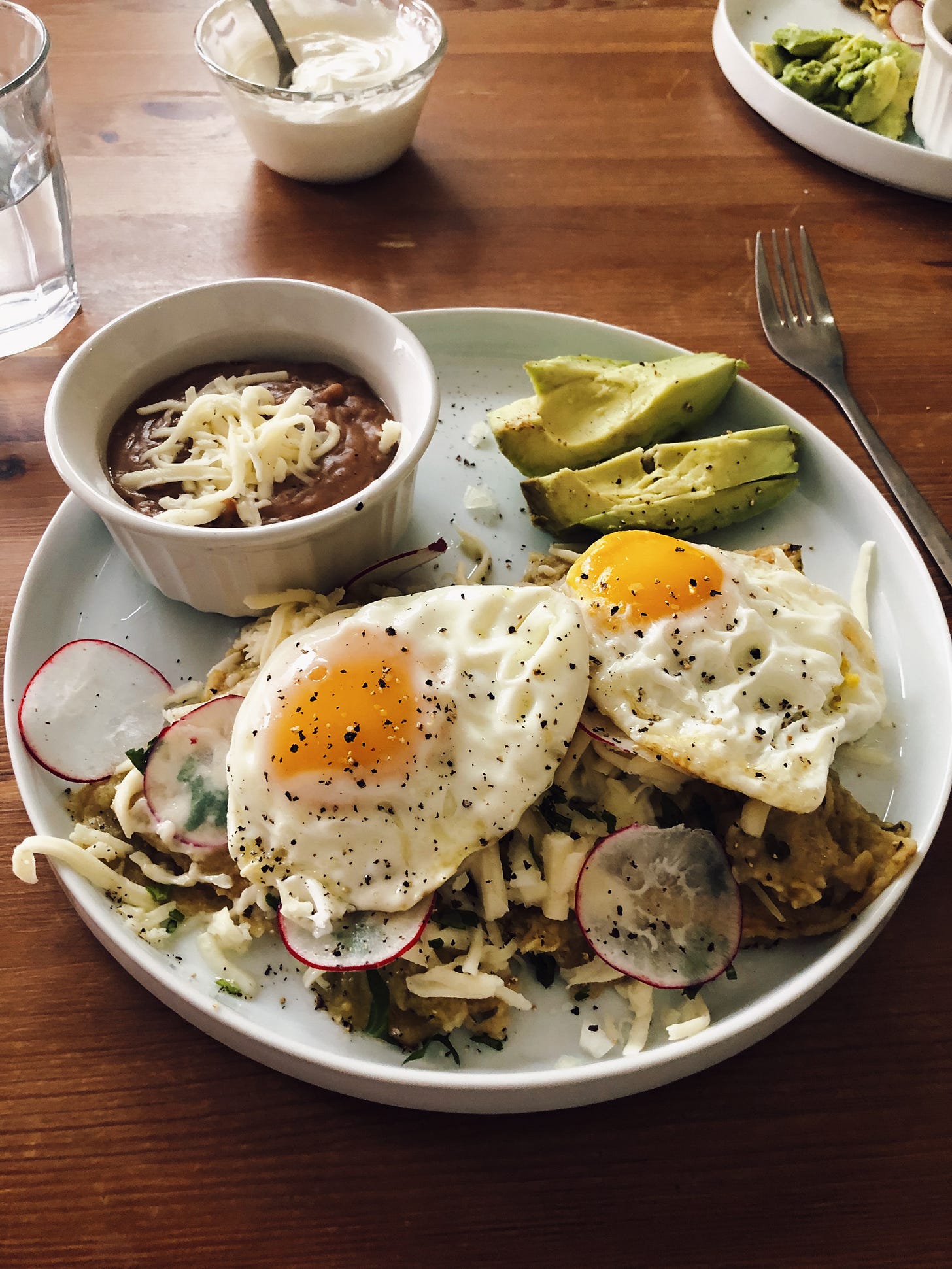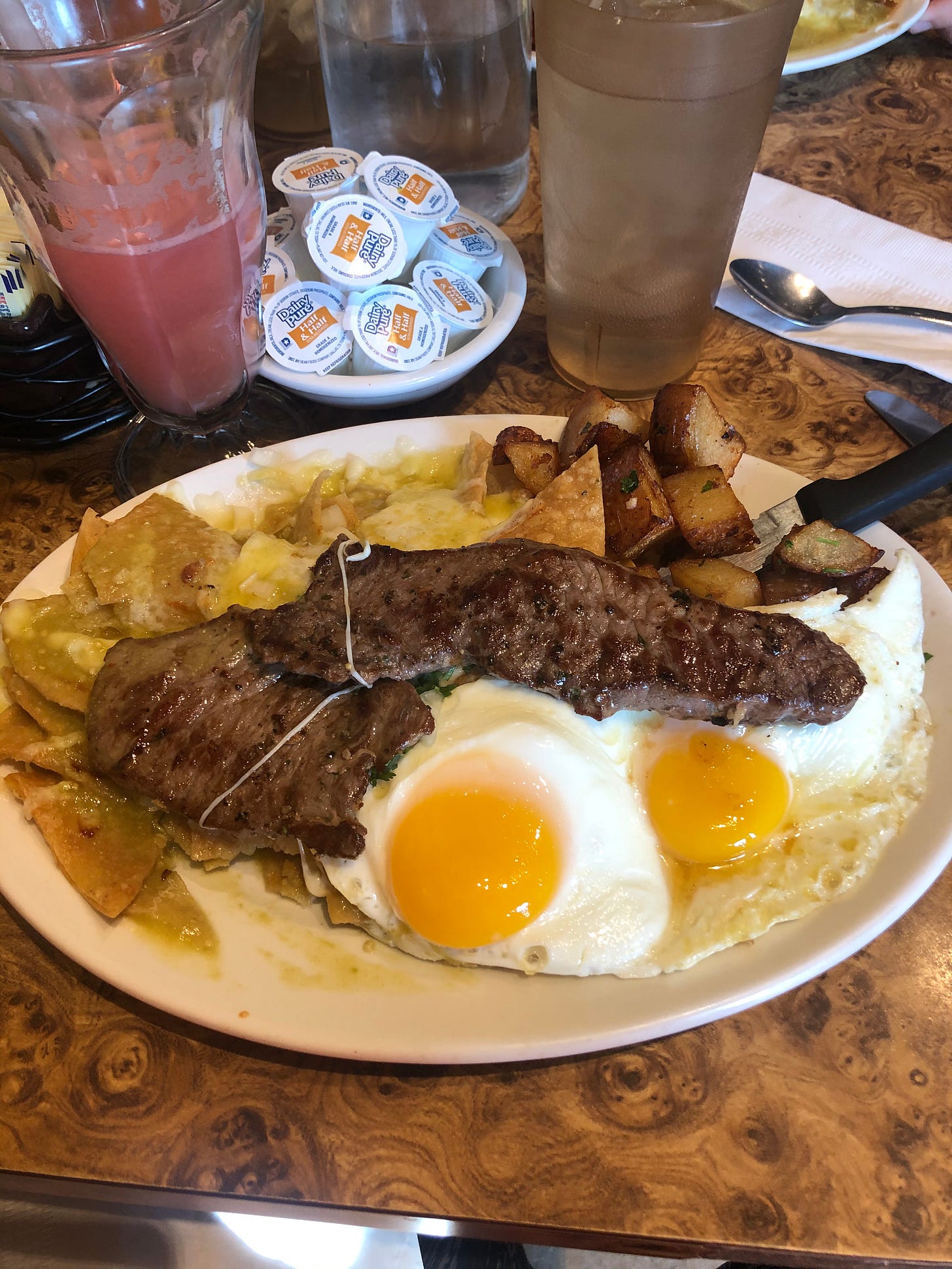Before we ever met for a date, Johnathan told me about a meal he'd had on some then-boss's dime at Pacific Standard Time, a stylish new Chicago restaurant that sadly has not survived the pandemic. I asked for details, expecting the usual indifferent Tinder small talk - "it was cool," or whatever. Instead, he typed dreamily about Chartreuse ice cream, and that the burrata was a touch too cold from the fridge. I was immediately intrigued, and not just because he followed up with the Frasier joke that the only thing better than an exquisite meal is "an exquisite meal with one tiny flaw we can pick at all night."
Some time passed, and then Johnathan cooked for me for the first time. We fell in love chopping onions at his kitchen table, talking about work or our families or politics. I marveled at the beautiful but unfussy dishes that came to life in his hands — at how making dinner could be such an act of love instead of a chore even on our hardest, brokest, most beaten down days.
Many meals followed, and as I write this from our home together 2.5 years later, I know cooking doesn’t have to just be feeding and being fed. Johnathan and I cook to create beautiful little moments safe from work, from the world, from capitalism's mandate that we sell our labor. To make our own impossible standards possible, for a little while. We are starting this newsletter in the hopes you can find your own moments of joy through cooking, too.
For now, we're going to try and send you one recipe a week or thereabouts — an old standard, or J's latest culinary interest. We’re aiming for Fridays so you can do your shopping and have a lazy weekend with a new recipe. I will be your tour guide, editor and process documentarian. Johnathan is the true creative talent here, and will be writing or rewriting recipes, explaining his rationales, obsessions and arcane secrets, and doing much of the cooking. Call me the Ishmael to his Ahab, or something. Buddy is Queequeg. Rosie is...the whale? idk. Anyway, send us requests if you want! We'll see where this all goes.
We decided to start this project with a luxurious brunch standby in our house — chilaquiles. Because some Sundays, especially in These Unprecedented Times, you want to eat chips in the morning and just go straight back to bed. You can shortcut these with canned salsa and tortilla chips; don’t. Enjoy and talk soon —r
If breakfast is the most important meal of the day (it is), and chilaquiles are the greatest breakfast dish ever devised (they are), then it’s safe to say that chilaquiles are the most important food on earth.
I’ve eaten chilaquiles dozens and dozens of times in endless configurations, from styrofoam clamshells and greasy plates all over Chicago, on five consecutive hungover mornings in Mexico City and Coatepec, and on more than one occasion, directly from the pot, wincing, bleary, and trying not to make eye contact with my dog.
Chilaquiles are pure, unadulterated comfort, a symphony of ingredients that soars beyond the sum of its parts that defies any attempt to describe it in a way that does justice. “Basically, it’s stale, fried tortillas cooked in salsa until they start to turn soft”. If you love chilaquiles the way I do, you know that this dish is so much more.
For the uninitiated, the first question a server or cashier will ask you is “red or green?”. With one notable exception (Chicago’s Tiztal, where the chilaquiles are served in a salsa verde bursting with tomatillo brightness and alongside an inexplicable but welcome side of potatoes), I will always opt for red sauce, and that’s the version I’ll be explaining here. Red salsas can go a lot of different ways, but I love the fruity complexity of guajillos, and the árbol chilis add enough heat to compliment them.
If you’re fortunate enough to live somewhere like Chicago or LA where a thoroughly decent mouthful of chilaquiles is available at the end of your street, 24 hours a day, why should you read on? Because I truly believe these are worth the work and love that you’ll be putting in.
The good news is that most of this work (the salsa, and even the frying of the tortillas) can be done up to two days in advance, meaning you can wake up on Sunday morning and quickly throw everything together without breaking a sweat. -j
CHILAQUILES ROJOS
serves 2
10 corn tortillas (preferably day old and starting to turn hard)
Vegetable oil for frying
1 bunch of cilantro
1 medium white onion
8 árbol chilis
3 guajillo chilis
3 cloves of garlic (unpeeled)
3 small tomatoes (by small tomatoes, I mean the kind usually sold on the vine. Plum tomatoes also work)
2 small tomatillos
1 big pinch of cumin powder
1 small pinch of dried oregano
2 handfuls of queso quesadilla (or another white, melty Mexican cheese)
Crema Mexicana (or other pourable sour cream. American-style sour cream thinned with a little milk would work in a pinch)
4 eggs
Salt to taste
To prep the garnish:
Wash and dry the cilantro (you are washing your green stuff, right?), separate out the leaves and finely chop them. Before discarding the stems, chop a few big pinches of them and reserve for the salsa.
Dice the white onion and reserve about a quarter of it for the salsa. Put the rest in a bowl and fill with cold water. You’ll want to change the water a few times until the onion has a mild flavor and a crunchy texture.
To prep the salsa:
In a dry pan over medium-high heat, toast the chilis, moving them around often until they became soft and pliable. Set aside.
Heat up enough water to cover and rehydrate the dried chilis. Cover chilis with the hot water in a bowl and let them sit.
In the same dry pan used for the chilis, toast the garlic in its skin. The peel will protect the garlic from acquiring a burn taste, so don’t be shy here. Let it take on some heat until the skin starts to brown and can easily be slipped off. Move the garlic to the jar of a blender (or immersion blender cup).
Add the tomatoes and tomatillos to the same dry pan and roast them until their skins start to blacken. Once the skins start to loosen, remove the vegetables from the pan and let them cool until they can be handled. Remove the skins and add them to the jar of the blender.
Once the chilis are rehydrated and soft, remove them from the water, pull off the stems, and remove as many of the seeds as possible, reserving them. Don’t pour out the soaking water yet.
Add the chilis to the blender with everything else, along with the cumin and oregano. Blend until smooth, adding as much of the soaking water as needed to yield a pourable salsa.
Taste for salt and for heat. If you don’t cook with dried chilis often, you might be worried after your first taste. This salsa needs plenty of salt to bring it into balance, so don’t worry. If the salsa needs more bite, you can add in some of the reserved chili seeds and blend again. You’ll want to shoot for a salsa that hits the upper reaches of your heat tolerance, as we’ll be introducing several fatty ingredients the sauce will have to cut through.
Add a little vegetable oil to a saucepan and, over medium-high heat, sauté the reserved onion and cilantro stem until they become fragrant. Pour the blended mixture into the pot and bring to a simmer. Turn the flame down to low and cook for around ten minutes, until the salsa is delicious.
To prep the tortillas:
If your tortillas are fresh, you’ll want to dry them out in a pan until they shrink slightly and begin to lose their flexibility. Dried out tortillas fry up better.
Cut the tortillas down to bite sized pieces. Most restaurants cut them into triangles, but I think slightly smaller squares work a bit better and are easier to eat.
Heat a few inches of oil in a pot and fry the tortilla pieces in batches until they just start to become rigid. Keep in mind that tortillas continue to brown after they’re removed from the oil and can take on a nutty, burnt popcorn taste way before they look burnt, so be careful here. Drain the fried tortillas on paper towels and lightly salt them while they’re still hot.
To assemble:
Bring the salsa back up a simmer and check it one last time for seasoning. Add the fried tortilla pieces and give them a gentle stir. Cover the pot and lower the flame to medium-low.
Cook your eggs. I’d argue a runny yolk is an integral part of the magic of this dish, but if that’s not your vibe, just cook your eggs however you like. Poached can be nice, even. Scrambled is chaotic, but whatever.
By the time your eggs are done, the chilaquiles should be about al dente. Divide them between two plates and top with the shredded cheese, onions, cilantro, eggs, and crema. Salt and pepper your eggs, and go to town. Enjoy these with Topo Chico, rice and beans, coffee, avocado, a michelada; whatever your Sunday morning requires.








KING SHIT